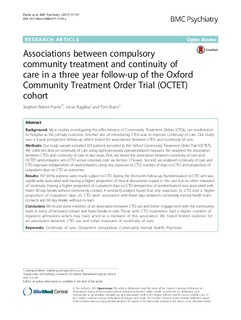| dc.contributor.author | Puntis, Stephen Robert | |
| dc.contributor.author | Rugkåsa, Jorun | |
| dc.contributor.author | Burns, Tom | |
| dc.date.accessioned | 2018-02-22T14:08:45Z | |
| dc.date.available | 2018-02-22T14:08:45Z | |
| dc.date.created | 2017-12-19T15:51:51Z | |
| dc.date.issued | 2017 | |
| dc.identifier.citation | BMC Psychiatry (2017) 17:151 | nb_NO |
| dc.identifier.issn | 1471-244X | |
| dc.identifier.uri | http://hdl.handle.net/11250/2486545 | |
| dc.description.abstract | Background: Most studies investigating the effectiveness of Community Treatment Orders (CTOs) use readmission to hospital as the primary outcome. Another aim of introducing CTOs was to improve continuity of care. Our study was a 3-year prospective follow-up which tested for associations between CTOs and continuity of care. Methods: Our study sample included 333 patients recruited to the Oxford Community Treatment Order Trial (OCTET). We collected data on continuity of care using eight previously operationalized measures. We analysed the association between CTOs and continuity of care in two ways. First, we tested the association between continuity of care and OCTET randomisation arm (CTO versus voluntary care via Section 17 leave). Second, we analysed continuity of care and CTO exposure independent of randomisation; using any exposure to CTO, number of days on CTO, and proportion of outpatient days on CTO as outcomes. Results: 197 (61%) patients were made subject to CTO during the 36-month follow-up. Randomisation to CTO arm was significantly associated with having a higher proportion of clinical documents copied to the user but no other measures of continuity. Having a higher proportion of outpatient days on CTO (irrespective of randomisation) was associated with fewer 60 day breaks without community contact. A sensitivity analysis found that any exposure to CTO and a higher proportion of outpatient days on CTO were associated with fewer days between community mental health team contacts and 60 day breaks without contact. Conclusion: We found some evidence of an association between CTO use and better engagement with the community team in terms of increased contact and fewer breaks in care. Those with CTO experience had a higher number of inpatient admissions which may have acted as a mediator of this association. We found limited evidence for an association between CTO use and other measures of continuity of care. | nb_NO |
| dc.language.iso | eng | nb_NO |
| dc.rights | Navngivelse 4.0 Internasjonal | * |
| dc.rights.uri | http://creativecommons.org/licenses/by/4.0/deed.no | * |
| dc.title | Associations between compulsory community treatment and continuity of care in a three year follow-up of the Oxford Community Treatment Order Trial (OCTET) cohort | nb_NO |
| dc.type | Journal article | nb_NO |
| dc.type | Peer reviewed | nb_NO |
| dc.description.version | publishedVersion | nb_NO |
| dc.rights.holder | The Author(s) | nb_NO |
| dc.source.volume | 17 | nb_NO |
| dc.source.journal | BMC Psychiatry | nb_NO |
| dc.identifier.doi | 10.1186/s12888-017-1319-x | |
| dc.identifier.cristin | 1529921 | |
| cristin.unitcode | 222,56,9,0 | |
| cristin.unitname | Senter for omsorgsforskning Sør | |
| cristin.ispublished | true | |
| cristin.fulltext | original | |
| cristin.qualitycode | 1 | |

